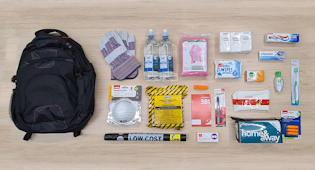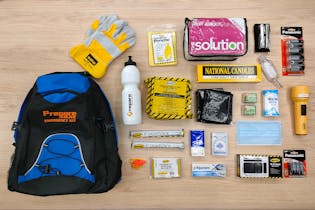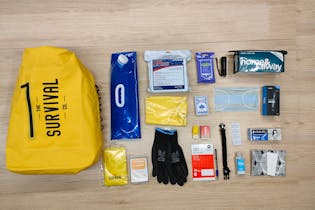How to make your own emergency grab bag
You can create your own kit for a lot less money than some premade ones, and it’ll be customised to you.

An emergency grab bag should have the essentials you need for at least three days away from home. It needs to be stored somewhere it’ll be easy to grab if you need to evacuate in an emergency.
This report is free thanks to funding from the National Emergency Management Agency (NEMA) and Toka Tū Ake EQC.
We put together a good quality kit for $160. It has all the basics and some handy extras. You could build a comparable grab bag for even less if you have a spare backpack or other items at home.
What’s in our grab bag
- Backpack: H&H University Backpack ($35)
- Drinking water: Market Kitchen still water 750ml x 2 bottles (2 years to expiry) ($2)
- Water purification: Aquatabs 50 pack ($8.49, Chemist Warehouse)
- Food rations: Mayday 3600 food rations (9 servings) ($28)
- Torch: Energizer compact metal light ($8.65, Mitre 10)
- Radio: Anko pocket AM/FM radio ($9)
- Batteries (two full sets): Number 8 AAA alkaline batteries 12 pack ($8.40, Mitre 10)
- First aid kit: Protec Home & Away first aid kit ($15.59, Pak’nSave)
-
Rain poncho: Anko heavy duty poncho with drawstring hood ($4.50, Kmart)
-
Foil blanket: Macpac thermal survival bag ($4.19)
- Whistle: Macpac emergency whistle ($2.09, Macpac)
-
Work gloves: Kiwi Garden leather palm gloves ($4, The Warehouse)
- Masks: Esko P2 respirator (3 pack) ($10.98, Mitre 10)
- Hand sanitiser: Dettol hand sanitiser 50ml (99¢, Pak’nSave)
- Soap: Dettol Bar Single Re-Energize Antibacterial 100g ($1, Pak’nSave)
-
Wet wipes: Pams Baby Fragrance Free Thick Wipes Travel Pack (24 pack) ($1.29, Pak’nSave)
- Tissues: Anko pocket tissues (6 pack) ($1.50)
- Toothbrush: Mouthfresh Adult Soft (99¢, Pak’nSave)
- Toothpaste: Macleans Protect Freshmint 90g ($1.19, Pak’nSave)
-
Thick plastic bags: Big Black Sacks Low Cost Bags 5 pack ($1.39, Pak’nSave)
- Pain killers: Pams Paracetamol 500mg tablets (20 pack) (99¢, Pak’nSave)
- Ear plugs: Esko Vortex class 5, 3 pairs ($5.96, Mitre 10)
- Pen: Sharpie permanent marker ($2.49, Mitre 10)
- Paper: Warwick 3B1 notebook (59¢, Pak’nSave)
Items available and prices correct as at December 2021

You can upgrade your grab bag by adding a multi-tool, duct tape and heavy duty safety pins for repairs. You could also consider adding body warmers or a small blanket in case it’s cold at night.
But don’t overload your backpack – it needs to be easy to carry for a length of time.
Don’t forget these essential extras
You’ll need to add warm clothes and a hat, any medications and sanitary items you need, any personal items you need such as spare hearing aid batteries and contact lenses, cash in small denominations, copies of photo ID and important documents, emergency contacts plus details and photos of your family and pets.
Also include supplies for anyone at home that can’t carry their own, such as anyone disabled, babies, small children, pets and other animals.

“I made a grab bag for my dog, Charlie, which includes food, her medicine, a small bowl, a spare leash, and an info sheet with her details and mine. It’s in a cheap waist pack I can wear comfortably with my own backpack. Having her gear separated from mine means I can find things quickly.” – Amy McNabb, Product test writer
Keep with your grab bag a checklist of essentials to grab on your way out – your wallet, phone and charger, personal items like glasses and hearing aids, sturdy shoes and jacket, extra food, your pets and any other animals, and keys for your house and vehicles.
Store some supplies in case you get stuck at home
In addition to a grab bag, you should have extra supplies stored at home in case you get stuck there in an emergency. You could be without power, running water or access to shops for several days or longer. See what to put in your home emergency kit here.
Have you got an emergency plan?
You can find out what to include in your home emergency plan here or download a template from getready.govt.nz. It’ll mean everyone in your household knows what to do and where to go in an emergency, no matter where they are.
This report is free thanks to funding from the National Emergency Management Agency (NEMA) and Toka Tū Ake EQC.

Living on an emergency grab bag
Our test writer, Amy, stayed on Matiu Somes Island for three days to trial a commercially made grab bag, comparing it to our DIY kit. Check out how it went.
We've tested 6 emergency grab bags and made one of our own. Find out how they compare.



Member comments
Get access to comment